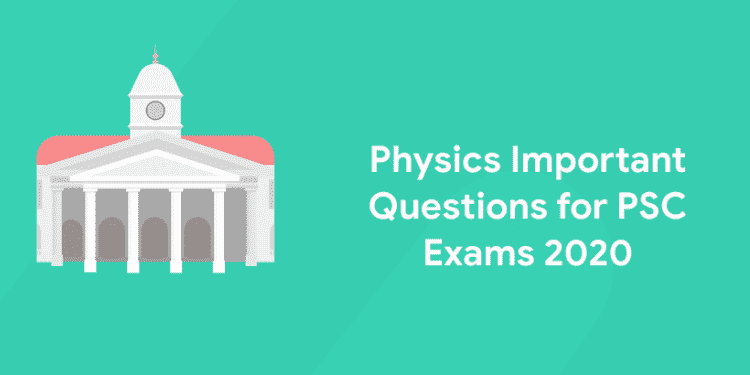Physics is one of the most fundamental scientific disciplines, and its main goal is to understand how the universe behaves. It is the study of the basic principles that govern the physical world around us. And it is one among the general science. For all PSC, UPSC and other competitive exams many basic questions will be asked from the Physics portions we have studied up to the 10th standard. We can say Physics is the natural science that involves the study of matter, its motion and behaviour through space and time along with related concepts such as energy and force. The main goal of physics is to understand how the universe behaves. This article gives some Important Questions for PSC Exams 2020.
Physics Important Questions for PSC Exams 2020
Every human beings can associate their way of living with Physics and inventions made through Physics. Physics can answer to many questions like, how did the universe begin, how the earth moves: rotation and revolution, what are the basic building blocks of matter, how will the universe change in the future, etc. Most of the questions asked in the PSC exams will be based on inventions and discoveries, scientists, theories, years, etc.
Start your exam preparation with Entri app
The following table shows the year, discoveries and the name of scientist.
| Year | Discoveries | Scientist Name |
| 1905 | Photon | Albert Einstein |
| 1897 | Electron | J.J.Thomson |
| 1919 | Proton | Ernest Rutherford |
| 1808 | Atom | John Dalton |
| 1932 | Neutron | James Chadwick |
| 1687 | Law of Motion | Isaac Newton |
| 1779 | Coulomb | Charles-Augustin de Coulomb |
| 1827 | Ohm’s Law | Georg Simon Ohm |
| 1831 | Electromagnetic Induction | Michael Faraday |
| 1880 | Thermionic Emission | Thomas Edison |
| 1896 | Radioactivity | Henri Becquerel |
| 1898 | Radium | Marie Sklodowska-Curie |
| 1900 | Quantum theory | Max Planck |
| 1905 | Photoelectric Effect | Heinrich Rudolf Hertz & Albert Einstein |
| 1895 | X-Ray | Röntgen |
| 1905 | Relativity | Albert Einstein |
| 1913 | Atomic Structure | Neil Bohr & Rutherford |
| 1942 | Nuclear Reactor | Enrico Fermi |
- What is the full form of ASLV?
(a) Augmented Satellite Launch Vehicle
(b) Automatic Satellite Launch Vehicle
(c) Aero Space Launch Vehicle
(d) Area Satellite Launch Vehicle
Ans: a
- Which is India’s first experimental satellite launch vehicle?
(a) ASLV
(b) GSLV
(c) SLV 3
(d) None of these
Ans: c
- When The Indian Space Research Organisation (ISRO) was set up?
(a) 1962
(b) 1969
(c) 1972
(d) 1952
Ans: b
Try more questions on Entri and get more practice on PSC
- Where is the Headquarter of ISRO?
(a) Chandipur
(b) Bengaluru
(c) Mahendragiri
(d) Chennai
Ans: b
- IRNSS is a ……………..
(a) Navigation satellite
(b) Space mission
(c) MARS mission
(d) Geo stationary satellite
Ans: a
- Who was the India’s first man/women in the space?
(a) Rajesh Sharma
(b) Rakesh sharma
(c) Kalpana chawla
(d) Sunita williams
Ans: c
- Satish Dhawan Space Centre (SDSC), SHAR is situated at…
(a) Bangaluru
(b) Mahendragiri
(c) Ahmedabad
(d) Sriharikota
Ans: d
- What was the Chandrayan I……..
(a) An earth observation satellite
(b) Lunar Probe
(c) Navigation satellite
(d) Geo stationary satellite
Ans: b
- Where is Vikram Sarabhai Space Centre?
(a) Thiruvananthapuram
(b) Odisha
(c) Kerala
(d) Andhra Pradesh
Ans: a
Get higher ranks by attempting free mock tests
- Where is master control facility in India?
(a) Hasan (karnataka)
(b) Bhopal (MP)
(c) Chandipur (Odisha)
(d) Both a & b
Ans: b
- Chief of the air force is called………………
(a) Admiral
(b) Air marshal
(c) Air Chief Marshal
(d) General
Ans: c
- What is the correct decreasing order of the officers in the Indian Army?
(a) Field marshal, General, Lieutenant General and Major General
(b) General, Field marshal , Lieutenant General and Major General
(c) General, Lieutenant General, Major General and Field marshal,
(d) General, Field marshal ,Lieutenant General and Major General
Ans: a
- Which of the following is not true about Agni V Missile?
(a) It’s an intercontinental ballistic missile.
(b) It is indigenously developed by India.
(c) Its range is between 5000-6000 kms
(d) It is run by liquid fuel.
Ans: d
- Which of the following missile works on the theory of “fire and forget”?
(a) Brahmos
(b) Akash
(c) Nag
(d) Sourya
Ans: c
- Which of the following is not true?
(a) Nirbhay is a missile of 1000 km
(b) Brahmos missile is developed by DRDO
(c) Astra is an Air to Surface missile.
(d) The range of Agni iii is between 3000 to 5000 kms.
Ans: c
Download Entri app and learn more important questions on Physics and other subjects too. The PSC aspirants will get subject wise classes, previous year question papers, live video classes, doubt clearing sessions, etc. Entri wishes good luck to all the aspirants.











